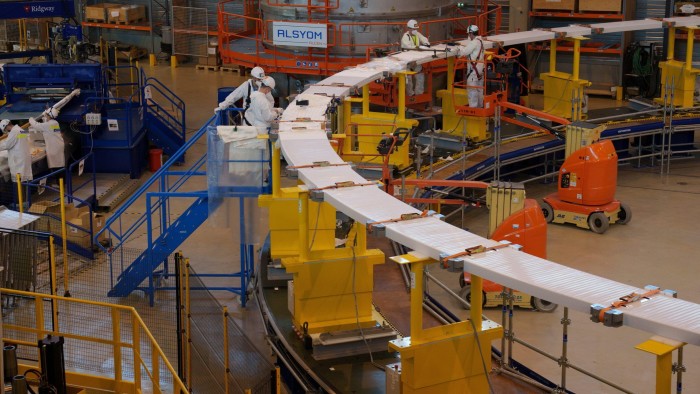New nuclear reactor rules ease fusion confusion

Roula Khalaf, Editor of the FT, selects her favourite stories in this weekly newsletter.
Energy lawyers are hoping that new rules for the regulation of fusion power in the US will set a global precedent that makes it easier to roll out the potentially revolutionary technology around the world.
In April, the US Nuclear Regulatory Commission voted to regulate fusion energy separately under a less onerous regime than fission — a landmark decision that lawyers and industry executives say was needed to give the technology a chance of helping to cut emissions.
The fusion reaction, which is the same one that powers the sun, occurs when the atomic nuclei in two hydrogen isotopes — normally, deuterium and tritium — are fused. This process releases helium and vast amounts of energy, but emits no carbon. Scientists estimate that just a small cup of the hydrogen fuel required could theoretically power a house for more than 800 years.
Importantly, unlike fission energy — which is created when uranium atoms are split and thereby produces nuclear waste — fusion reactions create no long-lived radioactive byproduct and could never result in a nuclear accident, such as at Chernobyl in 1986.
And it is because of these different risk profiles that energy lawyers, such as Jeffrey Merrifield at Pillsbury, had been lobbying the NRC to treat fusion technology differently from traditional fission reactors.
“We had a tall mountain to climb to basically disentangle fusion technologies from the regulatory process for fission and really convince the NRC commissioners that the right way to go was to differentiate it,” he says. “Fusion has its own issues, but it doesn’t have the risk or complications of a fission-based reactor.”
Future fusion reactors in the US will instead be regulated under the same regime as particle accelerators, according to the NRC, which is now drafting specific rules for the nascent fusion sector.
This decision should make the development of prototype fusion devices — and, it is hoped, future power plants — faster. It should remove the need for expensive regulatory approvals, insurance and safety provisions that in contrast add costs to new fission power plants.
The restrictions on fission reactors have made it harder for the traditional nuclear industry to innovate, says Amy Roma, an energy lawyer at Hogan Lovells, who has also consulted with the NRC on the regulatory framework for fusion.
“Fission cannot iterate prototypes, because they need a very expensive NRC licence to even build a prototype,” she says. “So you can’t build it, see what works, take it apart, rebuild it.” In contrast, fusion start-up Helion Energy, which is based in Washington state and is backed by OpenAI chief executive Sam Altman, is building its seventh prototype fusion device in a little over a decade. “They have been able to iterate and move forward and figure out what works . . . in a way that fission never can,” Roma explains.
The UK, arguably, has gone even further than the US, advising in June 2022 that future fusion facilities in Britain will be regulated by the Environment Agency and the Health and Safety Executive, rather than the country’s Office for Nuclear Regulation.
“In some ways, [the UK approach] is even more innovative in that they’ve completely moved it out of the nuclear regulator,” says Andrew Holland, executive director of the Fusion Industry Association, a US-based trade body.
“There is a certain competitiveness aspect to this,” he adds. “The first countries that can set up an appropriate regulatory regime for fusion might be the ones that attract the early pilot plants.”
Commonwealth Fusion Systems, which is backed by US tech billionaire Bill Gates, is now building a large-scale demonstration device in Massachusetts. Meanwhile, UK-based Tokamak Energy has said it will construct its next prototype at the UK Atomic Energy Authority’s fusion research centre in Culham, near Oxford.
Despite this regulatory progress, fusion remains years away from supplying electricity to the grid. In December last year, scientists at a federal laboratory in California used a giant laser to achieve energy gain in a fusion reaction for the first time, but the experiment still produced only slightly more energy than was in the laser used to trigger the reactions. Physicists estimate that commercial fusion will require reactions that generate between 30 and 100 times the energy going in.
More than 40 companies are trying to develop these fusion technologies, with several — including CFS and Tokamak Energy — aiming to complete demonstration plants capable of generating electricity in the 2030s.
Industry experts are increasingly optimistic that some of these companies will succeed and that consistent regulatory regimes could allow for faster deployment of the technology in the 2040s. “To the extent that we can create alignment, that makes it a lot easier to commercialise and export these facilities,” says Roma.
In this way, the fusion industry is hoping to learn from mistakes made in the international regulation of fission, where variability in how individual countries regulate the sector has restricted growth, says Pillsbury’s Merrifield, who is a former NRC commissioner.
He hopes that the approach taken by the US, the UK and Canada — which, he notes, has adopted a similar stance — will be embraced by the UN-backed watchdog, the International Atomic Energy Agency. This would result in a more “harmonised” global attitude to fusion regulation.
“It is powerful that the US, the UK and Canada have aligned on an approach that is really quite similar to how they would go ahead and regulate fusion,” he says. “So I think that provides an important foundational opportunity to use that as something for which the rest of the international community could potentially harmonise.”
The FIA’s Holland says the Japanese government is taking a “deep look” at the regulatory decisions taken in the US and the UK.
“The US nuclear regulatory regime is well respected around the world, so the hope is that we can point to this and say, ‘Hey look, the Americans do it this way, it is appropriate, it’s safe, it’s the gold standard’,” he says.

Comments